Long-Term Agricultural Operations
Candidate Reserve Study Area
North of Highway 26
August 20, 2009
Submitted by . . . . . . . . . . . . . . . . . . . SaveHelvetia.org
A local citizens' group whose goal is to preserve
all land north of Highway 26 as Rural Reserves
Justification for designation as Rural Reserves under OAR 660-027-0060 (2b), (2c), (2d)
When identifying and selecting lands for designation as rural reserves intended to provide long-term protection to the agricultural industry or forestry industry, or both, a county shall base its decision on consideration of whether the lands proposed for designation:
RR (2)(b) Are capable of sustaining long-term agricultural operations
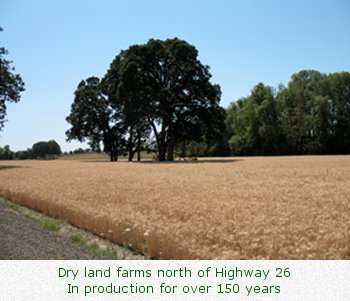 The area north of Highway 26 has a diverse, agricultural-based economy made up of many different types of agricultural-based businesses, including dry land farming, vineyards, Christmas tree farms, nurseries and nursery stock, U-Pick farms, pumpkin patches,
lavender farms, CSA's (Community Supported Agriculture), dairy and beef farms, walnut and hazelnut farms, equine businesses, ranching and dairy farms, hay and seed producers, and more.
The area north of Highway 26 has a diverse, agricultural-based economy made up of many different types of agricultural-based businesses, including dry land farming, vineyards, Christmas tree farms, nurseries and nursery stock, U-Pick farms, pumpkin patches,
lavender farms, CSA's (Community Supported Agriculture), dairy and beef farms, walnut and hazelnut farms, equine businesses, ranching and dairy farms, hay and seed producers, and more.
The land north of Highway 26 has been farmed profitably and successfully for nearly 150 years. This area has been so successful for so long because of its prime farming conditions: excellent soils, favorable rainfall and hydrology, and good parcel sizes, used by farmers who know how to innovate and diversify.
|
RR (2) (c) Have suitable soils and available water
Suitable Soils
The Oregon Department of Agriculture has already established that all the land north of Highway 26, currently designated as urban reserves and undesignated, is FOUNDATION AGRICULTURAL LAND. (See "Identification of Metro Region Agricultural Lands and Assessing Their Long-Term Commercial Viability", 2007. Oregon Department of Agriculture.) The use of the 1982 "Huddleston" report for soil analysis is outdated, biased towards irrigation and ignores other alternatives, such as tiling for sub-surface ground water control and crop choice. Crop choice, tract by tract, is a better method for determining the best use of the soils for a particular piece of land.
Greg Mecklem farms 200 acres in this area. In his testimony to the Washington County Reserves Coordinating Committee (WCRCC) on July 6, 2009, he stated that the majority of this land is Class I and II soils. Ryan Stadelman farms 800 acres this area; in his testimony of August 20, 2009 to the WCRCC he observed, "The soils around this area are some of the best in the valley. We can raise various types of grasses, grains, clovers and row crops. We produce better yields per acre and we have the best quality grass and clover that can be produced. This last spring many farmers in the area got a bonus on our wheat we sold because of the high protein content. In the Pacific Rim countries, they are very specific on the kind of wheat they buy because of the type of bread and pastries they make."
Available water
The area north of Highway 26 has adequate surface water, ground water and sub-irrigation from drainage. Sub-irrigation from the extensive tiling system that has been installed over the past 80 years provides an alternative to irrigation. This tiling system is common practice on all farm land in Washington County. Developing any part of this area would cause a break in the the tiling system and cause water to back-up onto adjoining land, rendering adjoining farmlands non-productive. Urbanizing the extensively-tiled farmland of Washington County will result in expensive infrastructure costs to compensate for the loss of the tiling, which is expected to result in more flooding and a loss of sub-surface irrigation capability for remaining nearby farms.
The farmers in this area are experienced dry land farmers. They efficiently utilize the water resources available to them. They are highly efficient at conserving the
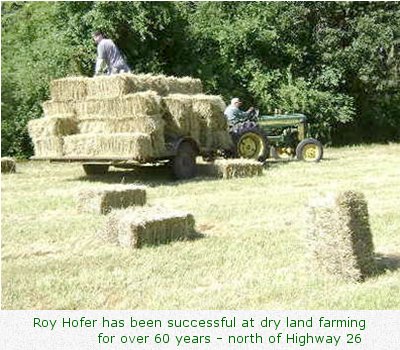 water they have. They select the appropriate crops to plant that will thrive in the ample rainfall that falls in the Northern Willamette Valley or that can be irrigated from the wells in the area. This area is one of the few places in the world where many crops receive enough moisture to grow well without irrigation, and yet crops do not need to be dried after harvesting.
water they have. They select the appropriate crops to plant that will thrive in the ample rainfall that falls in the Northern Willamette Valley or that can be irrigated from the wells in the area. This area is one of the few places in the world where many crops receive enough moisture to grow well without irrigation, and yet crops do not need to be dried after harvesting.
Pam and Spencer Gates farm 769 acres north of Highway 26. They grow wheat, oats, clover, grass seed and hay, all without irrigation. Ryan Stadelman farms 800 acres, almost all of these acres in dry land production.
Alan Schaaf, who farms 1,400 acres from NW Jackson Quarry Road to NW Germantown Road in the area north of Highway 26, testified to the WCRCC on August 20, 2009: "My operation is totally non-irrigated. Farmers that irrigate have found that this land requires more deep tillage, which is costly. Non-irrigated lands depend on natural rainfall to grow crops. I have deep soils and better natural drainage of excess rainfall than does farmland that is located closer to major streams and rivers. My farming requires less energy inputs than irrigated land and I can conclude that I leave a smaller carbon footprint."
|
RR (2) (d) Suitable to sustain long-term agricultural operations
Parcels are profitable
Farming multiple parcels is a common practice throughout Oregon; Washington County is no different. Farmers own, rent and lease lands throughout Washington County and Oregon. Existing parcelization is not a problem - it is an opportunity for diversification.
Matt Furrow farms 245 acres on 24 parcels of land north of Highway 26. He says, "Farming multiple parcels is successful for our farm.
I farm full-time year round, for our sole source of income." Alan Schaaf, a fourth generation farmer north of Highway 26, raises grass seed, wheat and Timothy hay on 1,400 acres. He says, "I have 62 different parcels ranging in size from 4 to 150 acres in size. I've been farming for over 30 years and with my experience I have found that all parcels regardless of size remain just as profitable."
Pam and Spencer Gates, fourth generation farmers, farm over 700 acres in five parcels ranging from about 15 acres to 300 acres. Ryan Stadelman, a third generation farmer north of Highway 26 says, "We have 21 different landlords for the 800 acres we farm. We have fields that range from 2.5 acres in size to 60 acres in size. All of them are profitable."
Infrastructure
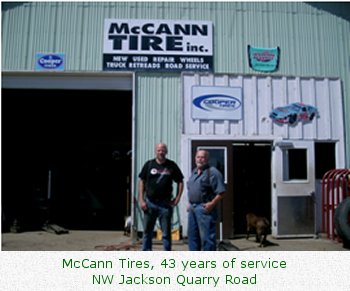 There is sufficient agricultural infrastructure to support farming operations in the land north of Highway 26.
Ryan Stadelman reports, "We have three different implement dealers and two chemical and fertilizer companies. If we lose acres to urban reserves, those companies will probably relocate." McCann Tires, located on NW Jackson Quarry Road, has served more than 100 farms in the area for over 43 years. If a tractor tire fails in the field during tilling, McCann Tires provides timely repair service on-site to minimize the time the equipment is out of service, thus increasing the farmer's productivity.
This time-saving service could be lost if additional farmland is urbanized.
There is sufficient agricultural infrastructure to support farming operations in the land north of Highway 26.
Ryan Stadelman reports, "We have three different implement dealers and two chemical and fertilizer companies. If we lose acres to urban reserves, those companies will probably relocate." McCann Tires, located on NW Jackson Quarry Road, has served more than 100 farms in the area for over 43 years. If a tractor tire fails in the field during tilling, McCann Tires provides timely repair service on-site to minimize the time the equipment is out of service, thus increasing the farmer's productivity.
This time-saving service could be lost if additional farmland is urbanized.
|
RR (2) (d) Suitable to sustain long-term agricultural operations
Started in 1958, the Oregon Century Farm program was designed to honor families working together for 100 years on their Oregon Farms. To qualify, the legal owner of the farm must show proof that the farm has been operated continuously by the same family for 100 years or more. Multiple state agencies support this program, including the Oregon Farm Bureau and the Oregon Department of Agriculture.
Eight Century Farm families continue their farming operations into their second centuries. Two of these families began their farming operations before Oregon became a state - over 150 years ago!
Century Farms north of Highway 26
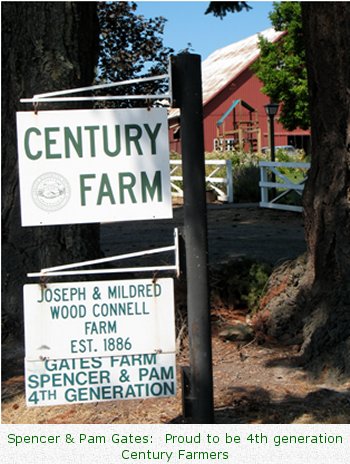
NW West Union Road
Joseph & Mildred Wood Connell II
Century Farm, 1886
NW West Union Road
Batchelder Century Farm, 1858
NW Old West Union Road
Walters Century Farm, 1890
NW North Avenue
Cropp Century Farm, 1907
NW Jackson School Road
Eli Davis Century Farm, 1847
NW Bishop Road
Bishop Century Farm, 1875
NW Helvetia Road
Abraham Yungen Century Farm, 1890
NW Helvetia Road
Pieren Century Farm, 1892
|
Effects of Urbanization on Productive Farmland
Placing the land north of Highway 26 into urban reserves will ruin the fertile farmland that has been productive for 150 years, put farming families out of work, and cause the businesses that support these farms to go out of business or relocate.
Pam and Spencer Gates, whose Century Farm has provided a livelihood for their family for over 123 years, states, "The effect of Urban Reserve designation on the land we farm would probably mean an end to farming as we know it. It would be too dangerous to drive our equipment from farm to farm. I am sure we would get many complaints about farm work that has to be done in the middle of the night and complaints about the dust and noise we make. As the population in the area has increased, we have seen an increase in trespassing, theft and vandalism."
Ryan Stadelman, who farms 800 acres in 21 parcels, observes, "And with urban reserves, farmers will have to fight more road traffic, more noise complaints, and there will be no buffer zone between houses and ag land. With those issues as farmers, we are probably not going to plant long-term crops, which are better for the environment and more profitable because of less tillage and labor costs. Who would want to enter a 5-year grass seed contract when the land it is planted on could be developed if it was classified as urban reserve?"
Matt Furrow, who farms 245 acres on 24 parcels of land, comments, "Farming multiple parcels is successful for our farm, but it is a burden when commuting across an increasingly congested urban area, and encountering closed roads to thru-trucks, making the drive even more difficult. In Washington County, I believe the majority of people would agree, that being surrounded by rural lands adds to their quality of life. In our so-called "Green Society", when emphasis is on preserving natural resources, shouldn't farms be number one on the list?"
Casey Schoch, whose family has owned and managed Schoch Dairy on NW West Union Road since 1966, would like to convert to on-site milk production.
To meet all the regulations, that investment could be up to $200,000.
Casey and Dave want to be able to offer locally produced milk in glass bottles because people in the Portland metro region want to be able to purchase organic, local, glass-bottled milk.
Casey says, "Our farm is proposed for urban reserves. With that designation, we are hesitant to make the investment in an on-site pasteurizing facility.
Having homes and businesses around us would negatively impact our dairy operation - we couldn't continue raising 200 cows in an urban environment."
Don Schoen farms 3600 hazelnut trees on NW Groveland Road.
"My farm is smack-dab in the middle of the proposed urban reserves. My hazelnut trees are only 60 years old and will continue to produce for 100 to 150 years, like in Europe.
We export about 35% of our crop - the rest is bought by local companies, such as Burgerville, for their hazelnut milkshakes and Oregon Bread, for their hazelnut bread.
I need the certainty of rural reserves in order to continue to invest in a long-term crop like hazelnuts."
|
Specialized Farms north of Highway 26 - Fruit Crops
The area north of Highway 26 offers an abundance of fruit-laden farms for summer picking. City dwellers increasingly want to buy locally grown, fresh food directly from the farmers who grow it. In 2009, several thousand visitors from the Portland metropolitan area and as far away as Canada, Australia, Russia, Israel, California, Washington, Idaho, and Georgia visited the area north of Highway 26 to harvest summer fruit from the area's U-Pick farms. Some of the most popular farms are:
Grossen Nursery - Peaches
Groveland Acres - Strawberries
Dos Sequoias - Cherries
Callaghans - Blueberries
|
Specialized Farms north of Highway 26 - Organic Agriculture
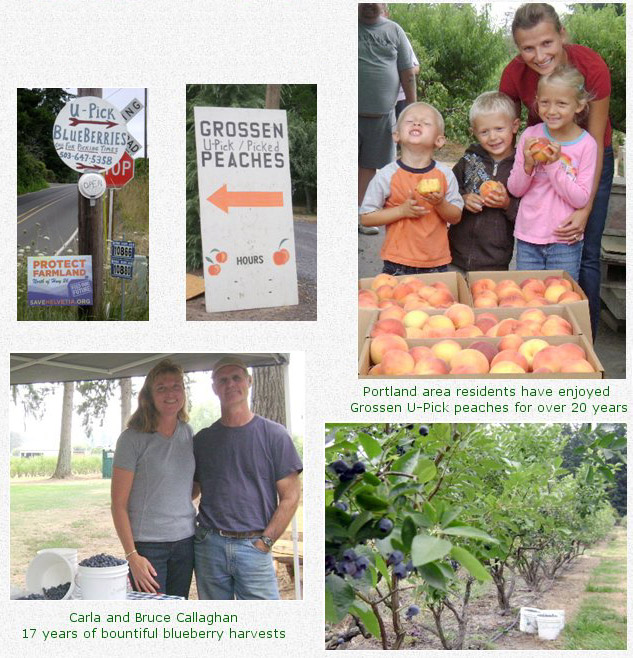
With the growth of farmers markets and an increased concern over the effects of artificial fertilizers and pesticides, organically grown food has created a solid niche for itself in the food market. Food grown prior to 1900 was considered "organic" because farmers produced crops for sustenance and profit using only natural means. To enrich the soil, farmers used a combination of animal manure and crop rotation.
In the last twenty years, many consumers are demanding food that is safe from pesticides and artificial fertilizers. They want to know where their food comes from. They want to know the person who grows it. Farmers markets in Hillsboro and Beaverton have grown in popularity as people flock to buy fresh, locally-grown produce.
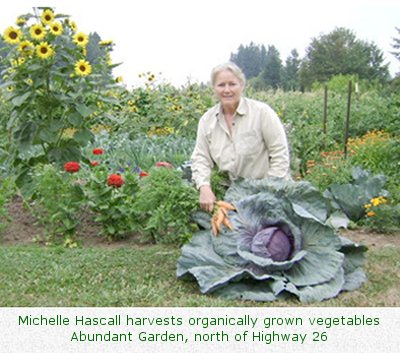 The residents of the area north of Highway 26 continue to demonstrate their ability to adjust to the changing needs of the market as they strive to provide healthy food using environmentally safe practices. Organic agriculture farms are here to stay.
The residents of the area north of Highway 26 continue to demonstrate their ability to adjust to the changing needs of the market as they strive to provide healthy food using environmentally safe practices. Organic agriculture farms are here to stay.
Michelle Hascall, owner of Abundant Garden, observes, "I have been farming here for five years.
I sell organically grown vegetables, fruit, nuts and I have a small nursery propagating from seed and division, annuals, veggies, perennials. The soil is excellent and I have plenty of well water. I get mostly local visitors who want fresh produce grown here in Helvetia."
|
Specialized Farms north of Highway 26 - Lavender Farms
Over the last ten years, residents of the area north of Highway 26 have continued to adapt to new trends in the agriculture industry. Four farms north of Highway 26 have found ways to capture the growing interest in lavender-related products and activities.
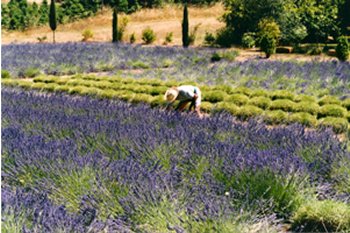
The Helvetia area provides ideal conditions for growing lavender. Helvetia's four lavender farms offer U-cut, essential oil distillation demonstrations, plants and gifts for sale, bath and body products, fresh bunches and dried bunches, wreaths, bouquets, tea, spice mixes, honey, jams & jellies and a host of other products.
An annual Lavender Festival and Tour takes place in July and includes the 30-plus lavender farms throughout western Oregon. During this tour weekend, the four Helvetia Lavender farms host several thousand visitors from the Portland area, in addition to visitors from as far away as Texas, Florida, Louisiana, Colorado, Korea, Japan and India.
Helvetia's four lavender farms are: Jackson School Lavender, Helvetia Lavender Farm, Bishop House Lavender and Seasonal Mary Herb-Flower Farm.
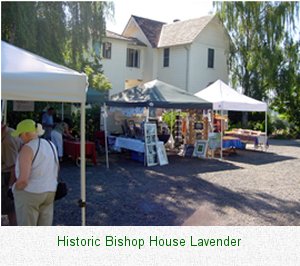
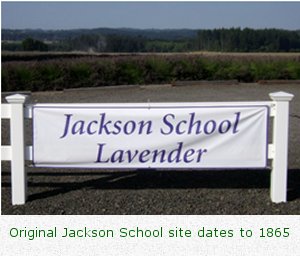
|
Farms north of Highway 26 - Fall and Winter Crops
U-Pick farms for fall and winter seasons north of Highway 26 feature pumpkin patches and Christmas tree farms. Visitors from all over Oregon visit these farms. Some of the more popular U-Pick and U-Cut farms for fall and winter include:
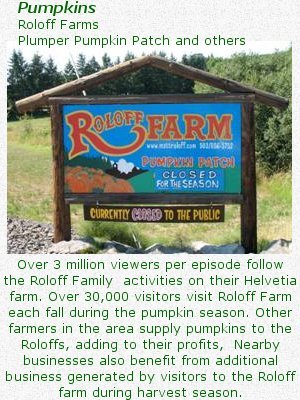
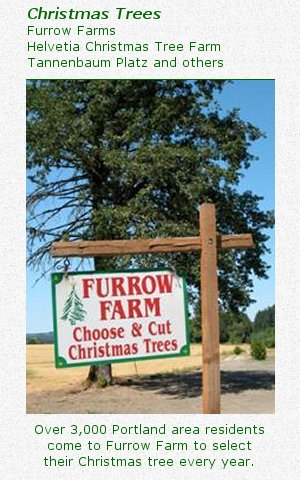
|
Specialized Farms north of Highway 26 - Vineyards and Winery
The Helvetia area north of Highway 26 is blessed with a climate similar to the grape-growing regions of Europe, fragipan soils and south-facing slopes. This combination of factors makes the sloped regions of the Helvetia area north of Highway 26 an ideal environment for growing winegrapes.
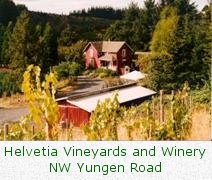
First planted in 1982, Helvetia Vineyards and Winery has 15 acres of south-facing slopes planted in Pinot Noir, Chardonnay and Pinot Gris varietals. Estate-Bottled wines are sold at the Helvetia Vineyards and Winery Visitors' Center and at retail stores throughout the west side of Portland, Seaside and Cannon Beach.
According to the Department of Geology at Portland State University, the soils at Helvetia Winery are Humic Fragixerepts, characterized by silt deposits that contain a dense, low permeability fragipan layer. They have developed in 15,000 year-old loess deposits (wind-blown silt). The slopes of the vineyards provide desirable grape production because of the superior drainage. Where the fragipan is found at a deeper depth, it allows the soil to drain better and the grape roots to extend further into the subsurface. The presence of pisolites (iron concretions) throughout the soil profile is favorable to the winery because they add rich, cherry flavors to the wine. See http://gsa.confex.com/gsa/2007CD/finalprogram/abstract_121228.htm
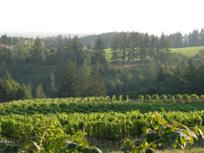
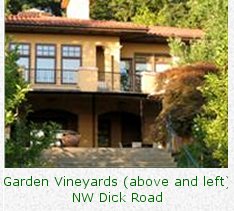
Garden Vineyards sells estate-grown Pinot Noir, Pinot Gris, Chardonnay, sparkling wines and varietal apple juices. First planted in 1992, its 25 acres under production have benefitted from the good soils and south-facing slopes of the Helvetia area north of Highway 26. Another 25 acres are prepared for planting in Pinot Noir and Pinot Gris in 2010.
|
Specialized Farms north of Highway 26 - CSA Farms
In the past five years, a new generation of Helvetia's entrepreneurs have capitalized on its fertile soils and natural beauty to develop a diverse economy of agriculture-based businesses that offer specialized products and services directly to customers. These fresh new faces of farming take Helvetia into the 21st century by offering sustainable, locally-grown food to Portland area residents.
Community Supported Agriculture (CSA) farms grow fresh produce and sell direct to consumers. Consumers join a CSA by signing up in advance for food shares. They commit to pay the cost of a share, covering the cost of the farm operation and the farmer's salary. In return, they receive fresh fruits and vegetables throughout the growing season, which can range from 26 to 52 weeks per year. CSA farm owners are committed to keeping Oregon's prime farmland in agricultural production and helping foster a local, sustainable agricultural system to feed our community with fresh, healthy seasonal produce.
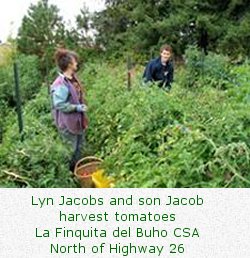
According to Lyn Jacobs, owner of La Finquita del Buho, a CSA located north of Highway 26, "People want to know where and how their food is grown, they want sustainably grown food and they want to take their children and grandchildren to the farms where that food is grown. Proximity is essential, community connection is quintessential. We provide that opportunity to this community through weekly pick-up at the farm, school trips,
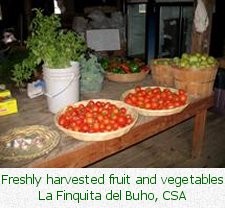 after school farm programs, community food preservation workshops and harvest festivals." after school farm programs, community food preservation workshops and harvest festivals."
Community Supported Agriculture (CSA) farms use natural resources sparingly. Jacobs notes, "We, at La Finquita, farm on drip irrigation only. We manage to feed people, replenish the land and preserve precious water without overhead irrigation. We manage this land with careful planning and hard labor and have proved that small acreage farming is possible and profitable."
There are three CSA farms in the area north of Highway 26: La Finquita del Buho, Abundant Harvest and Pumpkin Ridge Gardens. Together, these farms produce food for over 1,500 people in the Portland metropolitan area. They have wait lists of as many as 100 people. As Lyn Jacobs observes, "We are all examples of how much food can be produced in relatively small parcels of land. Farms range from one half acre to over 200 acres. Membership ranges from 30 members to over 350. CSA farming is economically viable and can produce $30,000 per acre."
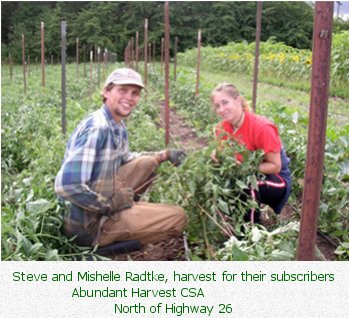
CSA farms contribute to the community in several ways. In addition to providing weekly food shares to members, CSAs also hold canning demonstrations, participate in harvest festivals, and sell vegetable seedlings and fresh-cut flowers at local Farmer's Markets. CSA farms host many school tours to show students how to grow affordable, sustainable and chemical- and pesticide-free food.
CSAs contribute to Hillsboro's high-tech community. According to Steve Radtke, owner of Abundant Harvest CSA, "We provide a significant amount of produce to Bon Appetit at four Intel campuses. Bon Appetit is a major food service company and their distinguished chefs know the value and quality of fresh, farm-direct produce."
|
Summary
The residents of the Greater Helvetia area north of Highway 26 have farmed profitably and successfully for the last 150 years. They follow traditional dry land agricultural practices to grow wheat, oats, clover, grass seed and hay, all without irrigation. They also are adapting, diversifying and innovating to new markets and techniques to produce new crops from the productive lands north of Highway 26. They have created a thriving economy of agriculture-based businesses that capitalize on the fertile soils and available water of the foundation agriculture land.
This land is capable of sustaining long-term agricultural operations, it has suitable soils and water and there is sufficient agricultural infrastructure to continue farming the area north of Highway 26 profitably and successfully.
This land meets all justifications for designation as Rural Reserves.
|
Acknowledgements
EditorCherry Amabisca
ContributorsAbundant Farms CSA
Bishop House Lavender
Callaghan's Blueberries
Grossen Nursery
Jackson School Lavender
Abundant Garden
La Finquita del Buho CSA
PhotographsCherry Amabisca
Steve Radtke
Adrian Amabisca
Thanks to John Talbot for his assistance in preparing this document for web publication.
|
Comments
August, 2009
"People pass nearby blueberry farms to come to ours because it is well maintained and for the surrounding beauty. It is their escape from the city and suburbs. They come and picnic and chat and bring their kids to see where the fruit comes from. They discover the flavor of hand-picked fruit that ripens on the bush. They enjoy getting great fruit at one half the cost they find in the store.
Our close proximity to the city/towns, yet completely rural setting is what they love. The quiet mornings with only birds and frogs as they pick the fruit. A 10-20 minute drive brings most here to find an escape in the country where farms, not house on house on house, meet the eye with such tranquility and beauty."
Bruce and Karla Callaghan
Callaghan's Blueberries
10880 NW Jackson Quarry Road
Hillsboro, OR 97124
August, 2009
"Our family has been on this property for over 100 years. Our 2009 greenhouses are producing cuttings of ornamental plants for Motz nursery. We have a peach orchard, we produce hay, grain, clover seed, etc. We have been one of the largest growers of Daphne in the U.S. We grow Red Haven, Vivid, Veteran and Suncrest peaches in our orchards. We have buyers come to our farm from all over the U.S. and Canada, as well as Australia, to buy our peaches. "
Glen and Laurine Grossen
23678 NW Grossen Drive
Hillsboro, OR 97124
July, 2009
"I have been in business since 1941. I am 97 years old. I farm 30 acres of hazelnuts, walnuts, hay and beef. We have good soil. We have good well water. I just put in more hazelnuts and they take 7 to 9 years to mature. I expect to keep on farming."
Roy Hofer
10177 NW Helvetia Road
Hillsboro, OR 97124
July, 2009
"We have been doing lavender growing and distribution for over 10 years but this property was owned by someone else before us and it has been farmed for over 100 years. We have good soil and water. We have over 1,000 visitors a year during the Lavender Festival and U-Pick. They come from all over different states, plus Portland, Hillsboro, North Plains, Beaverton."
Shouka Rezvani
11263 NW Helvetia Rd.
Hillsboro, OR 97124
July, 2009
"I have been farming here for five years. I sell organically grown vegetables, fruit, nuts and I have a small nursery propagating from seed and division, annuals, veggies, perennials. This property has been used for farming for 30 years (I rent from Roy Hofer). The soil is excellent and I have plenty of well water. I get mostly local visitors who want fresh produce grown here in Helvetia."
Michelle Hascall
10219 NW Helvetia Rd.
Hillsboro, OR 97124
August, 2009
"We have been farming on this property since 2003; the original owner has farmed since 1949. We grow lavender for U-cut, sale at farmer's markets and distillation of oil for production of retail products. We have good soil and good water. We get about 350 visitors during the Lavender tour weekend and for U-cut."
Tom Minnaert
10400 NW Jackson School Road
North Plains, OR 97133
August, 2009
"We have been in business for four years. We have a community supported agriculture (membership) farm. Families join for the growing season and receive weekly basket of fresh, organic produce, herbs and flowers. We also sell to local farmers markets. Our property has been used for farming for many years before us. We have good clay loam soil with great drainage and sun exosure ideal for our diversified vegetable, fruit, herb and flower production. We have an original ag well for that entire ag section. Over 90 families receive our produce weekly. We also host a large farm party in September with 200-250 attendees to celebrate our vibrant farm community. Our customers come from Hillsboro, Beaverton, North Plains, Aloha, Forest Grove and about 50% from Portland."
Steve and Mishelle Radtke
10440 NW Jackson Quarry Rd.
Hillsboro, OR 97124
|
Testimony presented to WCRCC, August 20, 2009
"My name is Matt Furrow; I own Furrow Farm on West Union Road, and I am the third generation in my family to farm in the Hillsboro area.
My family, employees and I, grow and sell Christmas trees for wholesale, and run a choose and cut operation from our farm; we also produce Hazelnuts and raise beef cattle. I farm full-time year round, for our sole source of income.
All of our acreage is non-irrigated, we rely on fertile soil and our plentiful rains. We currently farm 60 acres of Christmas trees, 145 acres of Hazelnuts, and 40 acres of beef cattle. A total of 245 acres on 24 parcels of land. Farming multiple parcels is successful for our farm; but it is a burden when commuting across an increasingly congested urban area, and encountering closed roads to thru-trucks, making the drive even more difficult.
Twenty-five years ago, Washington County was the number one producer of Hazelnuts in the United States. That all changed due to development in the Hillsboro area. Our operation alone lost 90 acres of production. We were fortunate enough to acquire orchards south of Hillsboro. Few climates anywhere in the world are suitable for hazelnut production and Oregon produces the best quality of nuts.
Our retail supplies Christmas trees to approximately 3,000 homes and we wholesale to several local nursery outlets, besides shipping out of state. Many families in the Portland metro area enjoy coming to our rural farm to choose their tree.
Weeds thrive and spread seed on poorly managed industrial sites, which has been the norm, not the exception; as farmers to strive to control invasive weeds.
In Washington County, I believe the majority of people would agree, that being surrounded by rural lands adds to their quality of life. In our so-called "Green society", when emphasis is on preserving natural resources, shouldn't farms be number one on the list? "
|
Testimony presented to WCRCC, August 20, 2009
"My name is Ryan Stadelman. I am a third generation farmer. My grandfather started farming in the 1930s. He cleared patches of brush and turned his land into a productive farm acreage and as he produced more he bought more land to farm. What my granddad started now supports two families.
We have 21 different landlords for the 800 acres we farm. We have fields that range from 2.5 acres in size to 60 acres in size. All of them are profitable. Most of it is dry land. We are fortunate here in the Northern Willamette Valley, we get ample rainfall and have a variety of crops to raise. We use the crops in rotation to combat disease, weed control and build up nutrients in the ground for future crops.
The soils around this area are some of the best in the valley. We can raise various types of grasses, grains, clovers and row crops. In the south valley around Eugene and Harrisburg the main crop is annual ryegrass, white clover and some wheat. Their soils are not as well drained and it limits what they can grow. We produce better yields per acre and we have the best quality grass and clover that can be produced. This last spring many farmers in the area got a bonus on our wheat we sold because of the protein content. In the Pacific Rim countries, they are very specific on the kind of wheat they buy because of the type of bread and pastries they make.
I was told that this is the only place in the world where we get enough moisture to sustain most of our crops without irrigation but also don't have to dry them after they are harvested.
The infrastructure in the area supports farming, too. We have 3 different implement dealers and 2 chemical and fertilizer companies. If we lose acres to urban reserve, those companies will probably relocate. And with urban reserves, farmers will have to fight more road traffic, more noise complaints, and there will be no buffer zone between houses and ag land. With those issues as farmers, we are probably not going to plant long-term crops, which are better for the environment and more profitable because of less tillage and labor costs. Who would want to enter a 5-year grass seed contract when the land it is planted on could be developed if it was classified as urban reserve?"
|
Next: Wildlife habitat
Back to Making our case
|









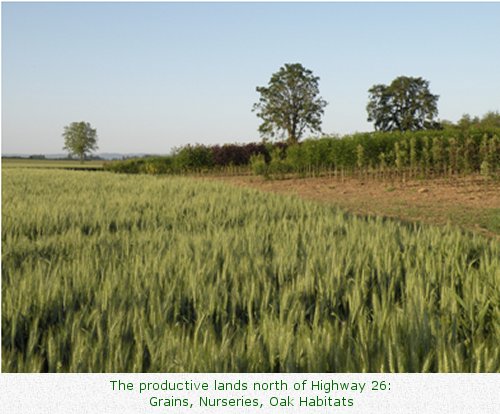
 The area north of Highway 26 has a diverse, agricultural-based economy made up of many different types of agricultural-based businesses, including dry land farming, vineyards, Christmas tree farms, nurseries and nursery stock, U-Pick farms, pumpkin patches,
lavender farms, CSA's (Community Supported Agriculture), dairy and beef farms, walnut and hazelnut farms, equine businesses, ranching and dairy farms, hay and seed producers, and more.
The area north of Highway 26 has a diverse, agricultural-based economy made up of many different types of agricultural-based businesses, including dry land farming, vineyards, Christmas tree farms, nurseries and nursery stock, U-Pick farms, pumpkin patches,
lavender farms, CSA's (Community Supported Agriculture), dairy and beef farms, walnut and hazelnut farms, equine businesses, ranching and dairy farms, hay and seed producers, and more. water they have. They select the appropriate crops to plant that will thrive in the ample rainfall that falls in the Northern Willamette Valley or that can be irrigated from the wells in the area. This area is one of the few places in the world where many crops receive enough moisture to grow well without irrigation, and yet crops do not need to be dried after harvesting.
water they have. They select the appropriate crops to plant that will thrive in the ample rainfall that falls in the Northern Willamette Valley or that can be irrigated from the wells in the area. This area is one of the few places in the world where many crops receive enough moisture to grow well without irrigation, and yet crops do not need to be dried after harvesting. There is sufficient agricultural infrastructure to support farming operations in the land north of Highway 26.
Ryan Stadelman reports, "We have three different implement dealers and two chemical and fertilizer companies. If we lose acres to urban reserves, those companies will probably relocate." McCann Tires, located on NW Jackson Quarry Road, has served more than 100 farms in the area for over 43 years. If a tractor tire fails in the field during tilling, McCann Tires provides timely repair service on-site to minimize the time the equipment is out of service, thus increasing the farmer's productivity.
This time-saving service could be lost if additional farmland is urbanized.
There is sufficient agricultural infrastructure to support farming operations in the land north of Highway 26.
Ryan Stadelman reports, "We have three different implement dealers and two chemical and fertilizer companies. If we lose acres to urban reserves, those companies will probably relocate." McCann Tires, located on NW Jackson Quarry Road, has served more than 100 farms in the area for over 43 years. If a tractor tire fails in the field during tilling, McCann Tires provides timely repair service on-site to minimize the time the equipment is out of service, thus increasing the farmer's productivity.
This time-saving service could be lost if additional farmland is urbanized.

 The residents of the area north of Highway 26 continue to demonstrate their ability to adjust to the changing needs of the market as they strive to provide healthy food using environmentally safe practices. Organic agriculture farms are here to stay.
The residents of the area north of Highway 26 continue to demonstrate their ability to adjust to the changing needs of the market as they strive to provide healthy food using environmentally safe practices. Organic agriculture farms are here to stay.








 after school farm programs, community food preservation workshops and harvest festivals."
after school farm programs, community food preservation workshops and harvest festivals."